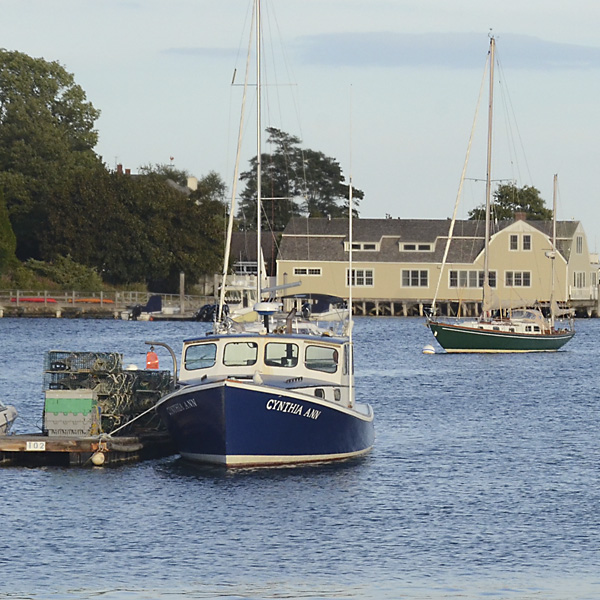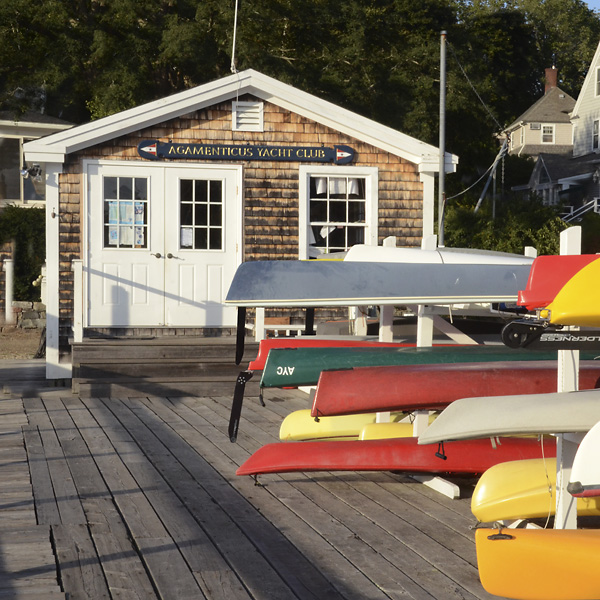York Harbor
York Harbor is the most secure harbor between Portsmouth and Portland, a fact that did not escape explorer Christopher Levett in 1624. “This is a good place for a plantation,” he wrote, “a good place for ships.” The harbor is a wonderful surprise, tucked behind Stage Neck, just up the York River, packed with yachts and lobsterboats, fishermen and summer folk. It is also a fashionable summer resort with antique stores and art galleries, beautiful homes and historic sites, beaches and walking paths.
The harbor’s security, however, comes at a price. The entrance requires a sharp turn in formidable current, with ledges close by on both sides. Despite the lighted bell buoy at the harbor entrance, a stranger would be courting disaster to attempt entering in fog or at night. A safer option is to run for Portsmouth Harbor, a few miles south.
Approaches
Approaches. York Harbor can be entered at all tides, but the sharp turn at nun “8” can be tricky during the maximum flood. From lighted red-and-white bell “YH” off York Harbor (43° 07.75’N070° 37.03’W), leave can “3” to port and nun “4” to starboard. Aim for Stage Neck Light (Fl 4s 10M), a red, triangular shape on a small, white box with a light on top. Stage Neck is a peninsula lined with condominiums running from northeast to southwest. Observe nun “6” and can “7” and stay to port of the line between can “7” and nun “8.” On a flood, the current will try to sweep you first toward Stage Neck and onto the ledge at nun “8” and then onto the opposite ledge at Harris Island. If you don’t see nun “8,” beware. On rare occasions it is pulled under by the current. Approach this turn with good steerage, keeping nun “8” a couple of boat lengths to starboard. Once nun “8” is abeam, make the sharp turn to starboard, keeping your eye on green daybeacon “11” marking the Harris Island Ledge to port. Beware also, particularly on weekends, that this part of the approach is often peppered with kayakers.
Once past Harris Island Ledge, the harbor is divided by Bragdon Island into North Basin and South Basin. Both basins are prone to silting. They were dredged to approximately 8 feet in 1996 but now have a controlling depth of about 6 feet. You can round out of the current in the mouth of the South Basin to catch your breath and get oriented to the harbor or to contact the harbormaster.
Leaving York Harbor is the reverse of entering, with the changing factors of tide and current. To avoid Harris Island Ledge, keep just to the left of midchannel and turn sharply to port around nun “8.” But be sure to keep track of where you are. A flooding tide will set you to port, and it is easy to be aiming at can “7” and end up on Stage Neck. A lot of bottom paint and ego has been left on these ledges. Ticonderoga is said to have cut the nun close many years ago when leaving and ended up high and dry on Stage Neck. The embarrassed captain offered the then-astronomical sum of $50 to be towed off in secrecy during the night.
Anchorages, Moorings
Anchoring is not allowed in York Harbor. Nor, thankfully, is jet skiing. MThe town has five transient moorings and also manages vacant moorings for visitors on a first-come, first-served basis. The moorings have controlling depths of about 9 feet and can accommodate boats to 50 feet. If you can’t reach the harbormaster, York Harbor Marine Service on Harris Island or Donnell’s Marine to the north may be able to help.
For the Boat
York Harbor Town Dock (Harbormaster David Hutchenson: Ch. 09, 16; 207-363-0433). In addition to transient moorings, the town has two town docks, the first by the bridge over the York River and the second along the causeway to Harris Island. There is no water or trash disposal.
Agamenticus Yacht Club (207-363-8510). Located on the north side of the harbor, the AYC clubhouse and dinghy floats are the second farthest docks to the right, nearest Stage Neck (the farthest docks to the right belong to the Harborside Inn). Club facilities are limited to a two-hour dinghy tie-up and water at the floats, but people there are cordial and helpful.
Donnell’s Marine (207-363-4308, 363-5324). Donnell’s dock is to the left of the yacht club and has four transient slips. They can accommodate large boats, with 10 feet along the outside at low. Water and electricity are on the dock.
York Harbor Marine Service (Ch. 09, 16; 207-363-3602; yorkharbormarine.com). Once past the narrows, York Harbor Marine is on the left, on Harris Island. DThey can provide transient dock space for lengths to 40 feet, with 5 feet of depth at low. Gas, diesel, water, ice, and electricity to 50 amps are available on the docks. Their ship’s store stocks parts for Johnson and Honda outboards. They can handle most boat and engine repairs, hauling with a 60-ton marine railway or a hydraulic trailer.
For the crew
York Harbor Marine has showers and laundry machines ashore. The town of York Harbor is a three-block crossroads at the north side of the harbor. It offers pleasant strolling, but little commerce. Land your dinghy at the yacht club or Donnell’s, or at one of the two town floats, on either side of Bragdon Island.
The nearest provisions are in York Village, one mile away via Route 1A. A laundromat is next to a convenience store and a bagel and pizza shop are nearby. On the way you’ll pass the large Foster’s Clambake Restaurant (363-1424).
The Dockside Restaurant (363-2868) on Harris Island is wonderfully situated at the turn of the entrance channel, overlooking the ocean and river. Lunch and dinner are served in a separate building with a screened porch. Walk out to the gazebo on the point and watch new arrivals negotiate (or fail to negotiate) the sharp turn.
The manicured lawns of the Stage Neck Inn lead to a lounge overlooking the adjacent town beach. The word “stage” comes not from stagecoaches but from early fishing days when cod was dried and salted on “stages,” or racks. The inn serves lunch and dinner by reservation (363-3850, 800-340-1130).
Things to Do
The town beach is a crescent of white sand where you can swim in gentle surf. At the north end of the beach, you’ll find the beginning of the Cliff Walk, which winds around the northern side of the harbor entrance between the sea and beautiful old summer cottages, making it one of the loveliest coastal walks in Maine. Beware, though, that the base of the walk gets covered at high tides or during storm conditions.
A storm of a different kind has been brewing over the public’s right to use the Cliff Walk. Adjacent property owners threaten to close the trail, claiming ownership and associated liability and privacy concerns. The town and a nonprofit are fighting to keep it open. As far as we know, the public is still allowed on the trail, but please respect the privacy of the landowners.
Another good walk starts at the Agamenticus Yacht Club or Donnell’s Marine. Go left on a path along the riverbank called the Fisherman’s Walk. Cross the road and walk over the mouth of Barrells Mill Pond on the pedestrian Wiggly Bridge, said to be the smallest suspension bridge in the world, and probably the most aptly named. The path leads through a wooded nature preserve until it reaches paved Lindsay Road. Take a right and stroll half a mile into York Village.
York Village is full of historic sites (oldyork.org). York originally was the Indian settlement of Agamenticus, wiped out by plague and resettled by colonists in 1630. Here Sir Ferdinando Gorges, friend of King Charles I, created the first city in North America in 1640. Anticipating becoming governor of New England, he called it “Gorgeana.” But with the triumph of Oliver Cromwell, Gorges lost his power, and the city of Gorgeana was demoted to the Village of York.
At the corner of Lindsay Road and York Street is Jefferds Tavern, and nearby is the Old Gaol. Built in 1719 with timbers from its 1653 predecessor, the Gaol is the oldest remaining English public building in the United States. Here you can visit cells and dungeons and the restored quarters where jailer William Emerson and his family lived cheek-by-jowl with the prisoners. His bedroom window even opened onto one of the cells.
Near the Old Gaol are several other buildings open to the public, including the Old Schoolhouse and the Old Burying Ground, with some fascinating headstones dating back to the early 1700s. A plaque in the cemetery says, “Near this spot are interred the remains of the victims of one of the worst massacres of colonial days. On Candlemas Day, 1692, on the dawn of a January morning, Abenaki Indians attacked the settlement of York, burning the houses and capturing 300 of its inhabitants. About 40 were killed. The rest marched to Canada, many dying on the way.” There the captured inhabitants of York were sold as servants to the French.
If you have a dinghy with an outboard, the upper reaches of the York River beg for exploration. Remember the strong current. You can land the dinghy at the John Hancock Warehouse and Wharf, now a museum, to shorten the walk into York Village.
Leaving York Harbor, if the weather suits, drop the lunch hook off the town beach outside Stage Neck in 10 to 12 feet of water at low, and have a swim. Head in for the middle of the beach, keeping halfway between nuns “6” and “4,” and anchor a little way past Fort Point.


